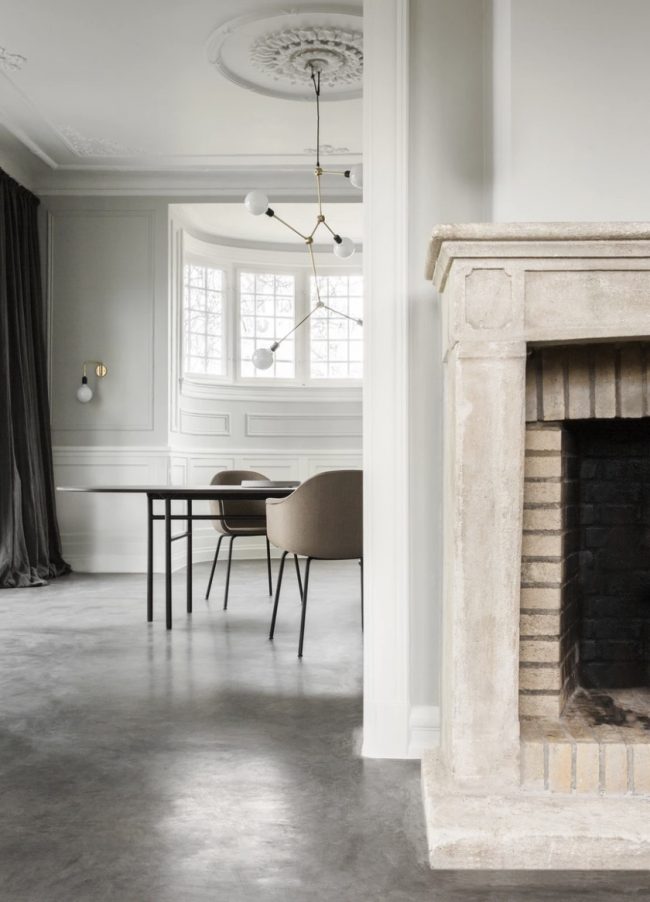From rough-hewn to refined, concrete has moved beyond the drab slabs of the past. Advancements have catapulted concrete into the world of architectural-grade products, alongside popular stone and wood options. The material has become synonymous with honesty and integrity. A concrete benchtop, sink or floor is a serious contender for those seeking a customised material with a natural sensibility: It’s widely adaptable, and as it turns out coming into its own as one of the most versatile options we’ve seen, aesthetically. Is concrete the right material for you and your house? And is it practical? Here’s the intel.
There’s a very strong emotional draw towards concrete—it’s the one material that accepts imperfections. Unfazed by associations with cellblocks and parking garages, more homeowners are discovering that concrete is the chameleon of construction. It can take on the texture of wood or glass, an artist’s palette of colour beyond drab grey and, with the addition of structural fibres and plasticisers, is less prone to cracking.
“It’s pretty much the standard concrete that’s always been used, but upgraded with new additives,” said Fu-Tung Cheng, whose Berkeley, California-based firm Cheng Design favours concrete for construction.“Most people’s immediate response about concrete is to think of freeways and parking lots—but if you use it properly, it’s like stone was in the old days, sculptural with a feeling of timelessness.”
Concrete has been around since ancient times, when Roman builders mixed lime, sand and rubble with volcanic ash to create the Pantheon dome.
Modern concrete swaps out the volcanic ash for cement. Concrete homes can be poured in place into forms made of plywood or steel plate and lined with everything from pine boards to mirror-smooth plastic laminate. Or they can be erected using precast concrete walls or blocks. The sturdiest concrete homes are reinforced with steel, making them strong enough to withstand fires, floods and hurricanes. Read more, ‘Renovating 101: Polished Concrete Floors.’
Concrete homes are more expensive to build than conventional homes, but they’re less expensive to maintain and more durable over time. Concrete affects the bottom line in other ways, lowering heating and cooling costs and even insurance premiums. They are more insect resistant, more mould resistant—also one of the most energy-efficient systems available.
Concrete is a natural composite material made from an aggregate (typically rocks, sand, and fly ash) plus a cement binder (such as limestone and calcium sulfate) and water. (For those wondering what the difference is between concrete and cement, the answer is that cement is a component of concrete: Pavements are made of concrete, not cement.) Several companies offer sustainable versions of concrete composed of high percentages of recycled content, including waste fly ash, glass dust, and rice husks. The finished product weighs about the same as granite. Read more, ‘Concrete Floors 101: How To Do Them.’
Unlike concrete benches of the past, the new concrete benchtops are lighter and some have polymers mixed in, so they don’t stain or crack.

The majority of today’s concrete benchtops are precast—and for good reason. Pictured is Mar Plus Ask’s Head Quarters in Berlin featuring concrete benchtops, sink and flooring. Image via marplusask.com
How is a concrete benchtop fabricated and installed?
Concrete benchtops are either precast offsite or cast in place during your kitchen construction.
Precast Concrete Benchtops
The majority of today’s concrete benchtops are precast—and for good reason. Made to order in any size you like, precast benchtops are poured in the controlled environment, enabling more colour and texture options as well as the ability to use modern reinforcement technology. Each bench is handmade, enabling customisation of shape, thickness, sink, and appliance cutouts, and additional details such as an integrated dish drainer. Precasting also offers the ability to create a wider range of edge options than you can make on-site. An identifying sign of precast concrete benches is that they come with visible seams, which is not necessarily a bad thing: Seams enable the bench to flex and move more, reducing the likelihood of cracks that occur with concrete’s natural shrinkage over time.
Cast-in-Place Concrete Benches
Benches are often cast in place in setups that require irregular shapes. And when poured on-site, benches typically do not have seams. Ambitious DIYers can try making their own; there are scores of how-to videos on YouTube, and other sites.
What colours and textures are available for concrete countertops?
Concrete benchtops can be made in virtually any colour, though stony grey continues to be the most widely used. Concrete finishes range from rough-hewn to diamond-polished. Although, there are natural variations in colour and texture that occur as the bench is crafted and cured; to concrete advocates, it’s one of the material’s appealing qualities.
Concrete benches mix well with other bench materials. Since they’re handmade, they have a character that simply doesn’t exist in stone or synthetic materials.
The great thing about concrete is that you can adjust the colour to be browner or bluer or whatever works with the overall palette.
Does a concrete benchtop need to be sealed and maintained?
Like most natural benchtop materials, concrete is porous and needs to be sealed to prevent staining. Depending on the sealant used, some discolouration and patina may develop—a chance outcome that’s appealing to some, terrible to others. Sealing technology is now so advanced that some fabricators call their concrete benches stain-proof, and provide warranties against staining. Talk to your supplier or builder about the best sealant for the look you want. Regular cleaning with nonabrasive cleaners is recommended, as is periodic waxing if your counters have a polished finish.
Maintenance is minimal with concrete benchtops.
How much do concrete benches cost?
Handcrafted and custom made for each application, concrete counters are not a budget item. Because of the variability of material and situation, prices range from $70 to $140 per square foot. According to Mark Rogero of Concreteworks, a good rule of thumb is to plan for $120 per square foot for a fully installed architectural-grade concrete counter.
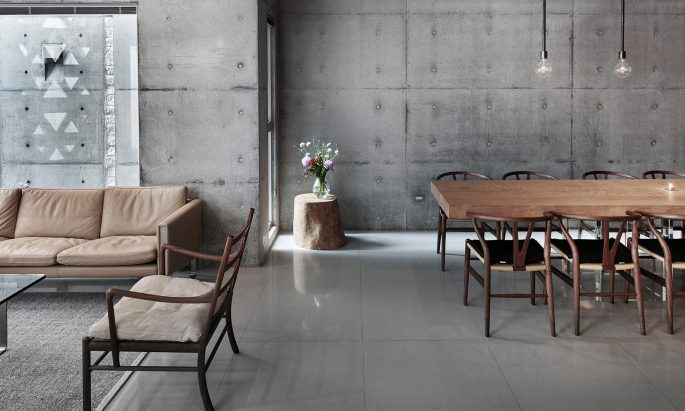
Properly sealed and maintained, concrete will wear well for years—and can be used indoors and out. House in Tainan Taiwan by VIPP, VIPP.com
Concrete Benchtop Recap:
Pros:
- Concrete benches are a custom handmade product that you can design to fit your space and aesthetic.
- Concrete is available in a wide array of colours that can be adjusted to match your palette.
- Despite being a hard surface, concrete provides a soft, textured, natural feel to benchtops.
- Properly sealed and maintained, concrete benchtops will wear well for years—and can be used indoors and out.
- Like other natural countertop materials, such as wood and stone, concrete counters develop a patina with use.
Cons:
- Concrete is a porous material and can stain. Sealing is key.
- Caused by the natural shrinkage of the material, concrete countertops can develop minor hairline cracks that are nonstructural—some consider these a flaw, others a positive textural characteristic.
- It’s hard to control concrete’s natural variations in colour and texture.
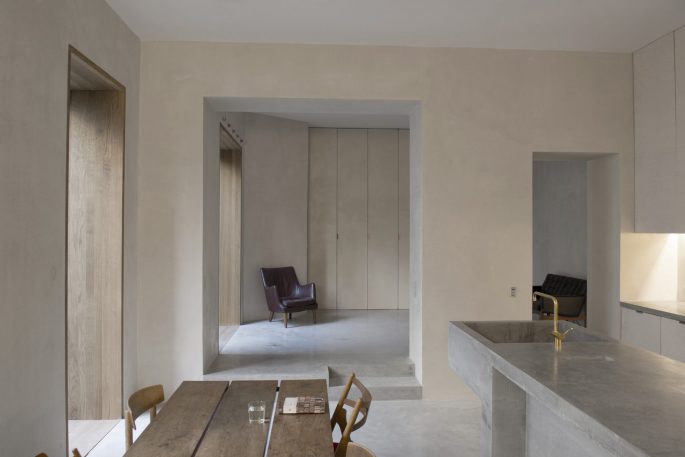
Despite being a hard surface, concrete provides a soft, textured, natural feel to spaces. Image of Mar Plus Ask’s Head Quarters in Berlin featuring concrete flooring, benchtop and sink. Via marplusask.com
Why choose a concrete sink?
What are the advantages of concrete sinks? Can you use them in the kitchen? Are there options beyond plain, sidewalk-coloured grey? It makes a statement. The concrete sink takes an inexpensive material, formerly used only for construction and foundations, and turns it into something sculptural and bespoke. In a world of manufactured items, with everything channeled to the mass market, a concrete sink offers the chance to use a relatively inexpensive material and create something that’s unique. A customised sink made of ceramic, for example, is considerably harder to produce, as it requires kiln-firing at high temperatures. But concrete, a much more forgiving material, is easily transformed into almost any shape you can imagine.
What are the advantages of a concrete sink?
You get to choose the size, shape, colour, and surface texture, so you can have a sink that fits perfectly, size-wise, into your space and suits your home’s style. The look of concrete works with a wide range of design styles—rustic or contemporary, traditional or hip. And unlike most marble, granite, and engineered stone, which often has to be shipped from abroad, concrete is made of locally sourced material—gravel rock, sand, and cement—and so, has a smaller carbon footprint.
What are the disadvantages of a concrete sink?
It’s not for perfectionists. Concrete has natural variations in colour and texture that might irk those looking for a uniform look, and it will show wear—or, to use a more appealing expression, develop a patina.
But the main drawback is that it’ll never be as hard as granite or engineered stone. Concrete is more like limestone in terms of hardness. That means it’s porous and must be treated to prevent staining and discolouration. It also means that the surface is fairly easily scratched and nicked.
Can you use a concrete sink in the kitchen?
We don’t recommend putting a concrete sink in a kitchen. The finish just won’t hold up over time, owing to the constant abrasion from pots, food chemicals, and harsh cleansers.
Nevertheless, many people are indeed installing concrete sinks in their kitchens and embracing the well-worn look that might come along with it.
For those less tolerant of imperfection, however, the bathroom provides a gentler home for the concrete sink; there, it’s subjected to little more than tooth-brushing and face-washing.
What types of concrete sinks are available?
The great thing about concrete sinks is that, when customised, they can be made in whatever length, width, and depth you want. And the style is variable too: you can create long trough sinks with two spigots for the bathroom, so that family members can share the space. Double sinks are also an option, as are vessel sinks, especially in smaller baths or powder rooms.
What textures and colours are available?
The surface texture can range from smooth and polished to matte or rough-hewn. As for the colour, it’s no longer one-size-fits-all grey. Today’s concrete can be tinted in a vast array of colours, though neutral colours work best. We prefer colours like those in nature, that aren’t too bright—and will stand the test of time.
Your concrete will be in place for the long run.
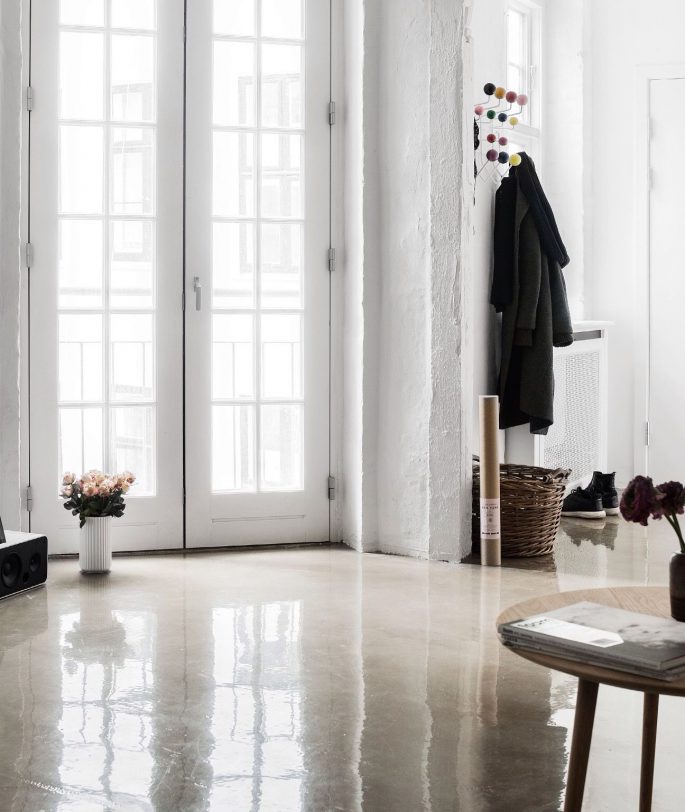
The surface texture can range from smooth and polished to matte or rough-hewn. As for the colour, it’s no longer one-size-fits-all grey. Image via UK Elle Decoration.
How do you care for a concrete sinks and benchtops?
Because concrete is porous, the surface must be sealed to protect it from stains and discoloration. There are two types of sealant, including something like urethane epoxy will keep out moisture and prevent staining, but it looks like plastic and can be impossible to refinish without stripping it off altogether. A better option is a slightly penetrating sealer that maintains a more natural look. It’s not bulletproof, but it gives you a surface that’s very restorable. A newly installed sink may come with sealant already applied; ideally, the homeowner will maintain the finish by spritzing on a polishing agent or using a wax. If you do either of those every few months, you may not have to refinish for a decade or more.
It’s still possible that stains or discoloration could appear—if, say, an irresponsible house guest spills an acidic food like red wine, vinegar, or lemon juice and allows it to seep in. Then you usually need a professional to polish out the stain using a very fine diamond pad and reapply the finish.
Does a concrete sink have to go with a concrete benchtop?
An integrated concrete bench and sink always look beautiful. Equally, it’s fine to mix and match your sink and benchtop. For people who want an integrated look in their kitchen, you can create a workaround: add a granite bottom to the sink. That means the splash area that gets the abuse is hard stone. It works, but it can be expensive—to create a slope in the granite.
What special features are available?
Since these sinks are custom-made, you call the shots. You can contour the dimensions any way that can be shaped in a mould. That could mean different edge finishes, such as rolled or bullnose, as well as built-in features such as drainboards.
WHAT’S A POURED FLOOR?
It’s a surface that is installed in-situ using a material in its liquid state, such as resin or concrete. The solution sets to form a smooth, solid and hard-wearing finish.
WHY CHOOSE A POURED CONCRETE FLOOR?
It’ll help you to achieve a unified look in your home. Concrete flooring connects spaces and helps the architecture flow in a way that modular types of flooring cannot.
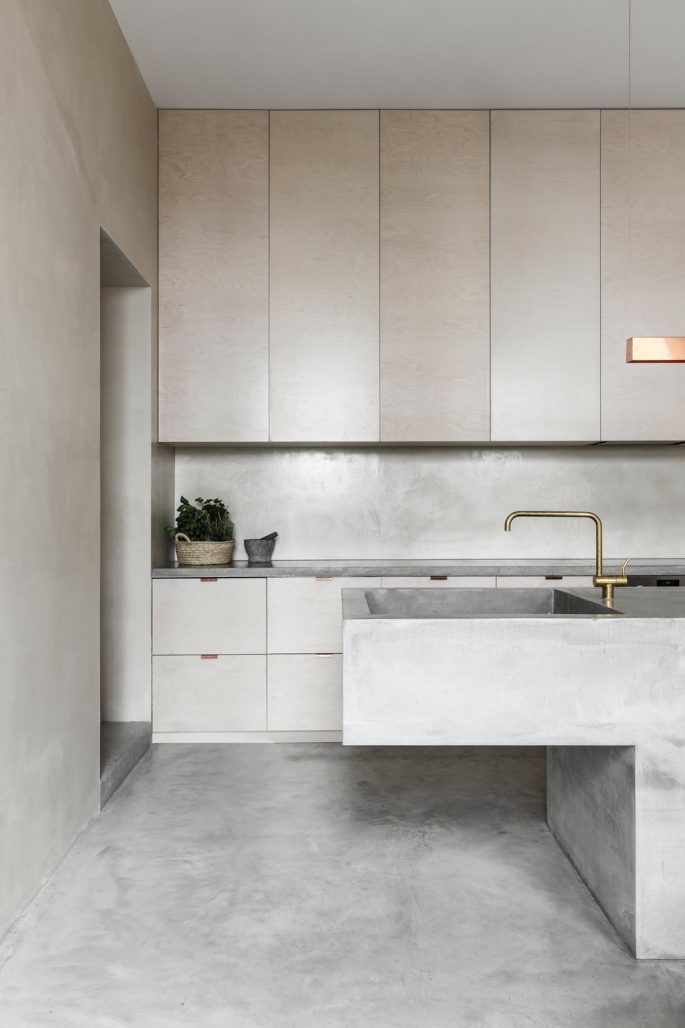
Mar Plus Ask’s Head Quarters in Berlin, marplusask.com
HOW DO I CHOOSE BETWEEN CONCRETE AND RESIN?
What distinguishes poured flooring products from others is the material that binds them. Concrete and micro-concrete (a thinner alternative) are cementitious, meaning they are bonded by cement. These materials carry a risk of cracking and have a high carbon footprint due to the amount of energy required to produce them, but do come with the benefit of an organic-looking finish. Resin floors are most commonly composed of one of three substances: epoxy, a low-cost option that is most suited to industrial use; polyurethane, a flexible crack-free material that offers comfort underfoot and colour that does not fade; and biopolymer, a natural option derived from plant oils. While biopolymer’s performance is similar to that of polyurethane, it is free from toxic chemicals, and by mixing it with quartz and stones you can make it look like polished concrete.
DO YOU NEED A SPECIALIST TO INSTALL ONE?
Yes. Pouring a concrete or resin floor is definitely a job for the professionals.
HOW IS IT DONE?
In theory, a poured floor can be applied to any stable surface. A layer of screed – a mix of sand and cement – should be added above any underfloor heating pipes before the flooring is poured on top. The protective layer takes at least a month to dry out. Be warned: the most common reason for imperfect results is a finish being applied while the screed is still damp. For houses with existing floorboards, preparing the substrata involves taking up the joisted timber and laying a damp-proof membrane and plywood boards before screeding. This creates a strong, air-and-water-tight base. Then if you’re using resin, the liquid is poured on layer by layer over a period of three to five days. For concrete, if your home is large enough for a floor depth of 100 millimetres and access for the machinery is required to install it, a slab can be poured into place in one go and power-trowelled, while wet, to create a smooth finish.
WHERE CAN YOU HAVE A POURED FLOOR?
In any interior space, it’s not a great option for outdoors because once laid it can become slippery when exposed to the elements.
A poured concrete floor is usually only suitable for ground-level installation because of the risk of cracking.
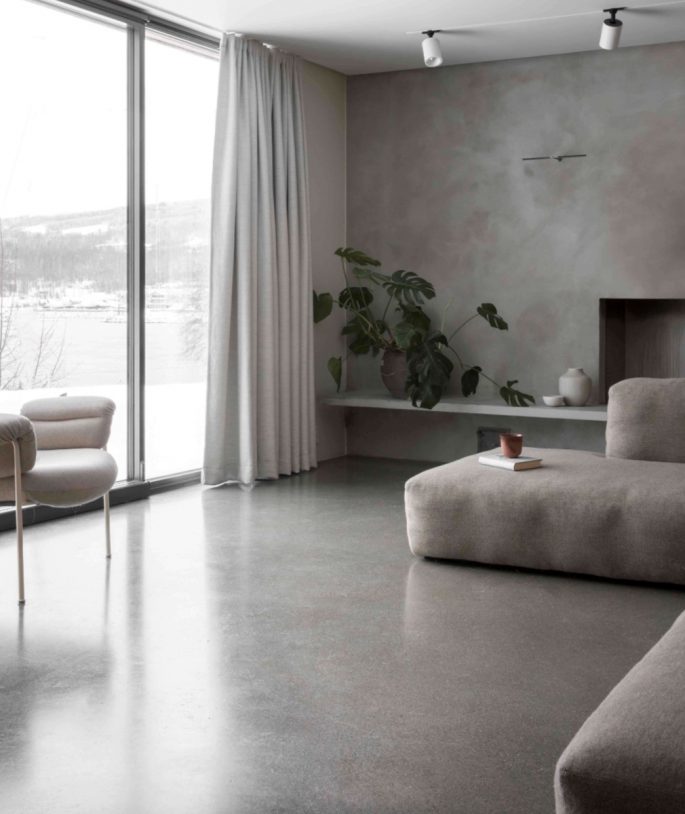
Concrete flooring connects spaces and helps the architecture flow in a way that modular types of flooring cannot. The Gjøvik House—a recent residence situated an hour outside of Oslo, Norway and designed by Norm Architects.
HOW DURABLE ARE POURED FLOORS?
They are stain and water-resistant, as well as being effective in absorbing sound, muting the click of heels. Concrete is much harder than resin floors: if you drop a glass on a resin floor it will bounce, whereas on concrete it would shatter. In terms of maintenance, a poured floor should be treated in much the same way as good-quality timber. To prevent scratching, avoid dragging furniture across it, and, to clean it, use a microfiber mop and a non-soap based product. If that all seems a bit too much like hard work, opt for a biopolymer resin floor instead. This hardy option just needs to be re-sealed with a fresh top coat every 10 years or so.
WHAT COLOURS AND FINISHES ARE THERE?
Resins come in virtually any colour imagineable. Cement floors tend to be less vibrant but can be stained with pigment – the most popular are shades of grey. The floors can be buffed and polished to create a sleek surface or left with a more natural, matte look.
WHAT’S THE COST?
It is site specific but generally considered an affordable flooring option. However, there is usually a minimum spend due to the logistics and labour costs involved in the installation process.
Investing in a skilled professional is worth the cost.
Can I hire a pro to grind the floors and I’ll do the staining or coating myself?
People often misunderstand the pricing. The surface prep, including grinding, is the bulk of the cost with concrete refinishing. “Say I quoted $6,000 to restain a floor,” he said. “If you only want me to do the prep work, it would still cost you $5,000.”
How can I re-stain my concrete floors?
To start, you’ll need to have the existing surface mechanically ground down, both to prime the concrete to accept a new stain and to remove as much of the offending color as possible. “You can’t control how much stain permeated the concrete in the original process,” Zamora says.It could be superficial and come off fairly quickly, or it could have permeated as deeply as half an inch down, which means it’s not going anywhere. You’ll need to mechanically grind your floors to determine your next step.

House in Tainan Taiwan by VIPP, VIPP.com
What does it mean to mechanically grind the concrete?
You need to use something harder than concrete in order to grind it down, which usually means a substrate like metal, ceramic, or resin that’s been impregnated with diamonds.
Diamonds are so strong that they can actually cut up the surface of the concrete.
Can I mechanically grind the floor myself?
If you’re imagining going over your floor with an electric hand sander, don’t. It’s a messy process, and the dust is dangerous. If someone is going to do this themselves, they must do a lot of research first and follow best practices to stay safe. To start, you’ll need to rent a mechanical grinder plus a large HEPA vacuum to filter the toxic particulates out of the air. These rentals will run you about $1,500 together. You’ll also want to be sure the particulates stay away from anything you’ll be living with—so all belongings and furniture must be securely covered, or, ideally, removed before work begins. (It’s obvious, but there’s no harm in stating it: People and pets should stay far away.)
The larger the project, the lower the price per square metre.” Concrete refinishing is about equal in price to having tile or carpet installed. But for a space any smaller, the cost per square metre might be between 50 and 200 percent more expensive.
Second, pricing is dependent on the space. One large rectangle will be much more affordable to refinish than five rooms that add up to the same square meterage. The more edges, corners, wardrobes, etc., the higher the cost.
Summary
“If you have the budget, hire skilled installers; your stain or coating can last between 15 and 20 years with proper maintenance. If you don’t have the budget, and you’re going to DIY, do everything you can to follow best practices from beginning to end, so you don’t have to relive the process again later.

